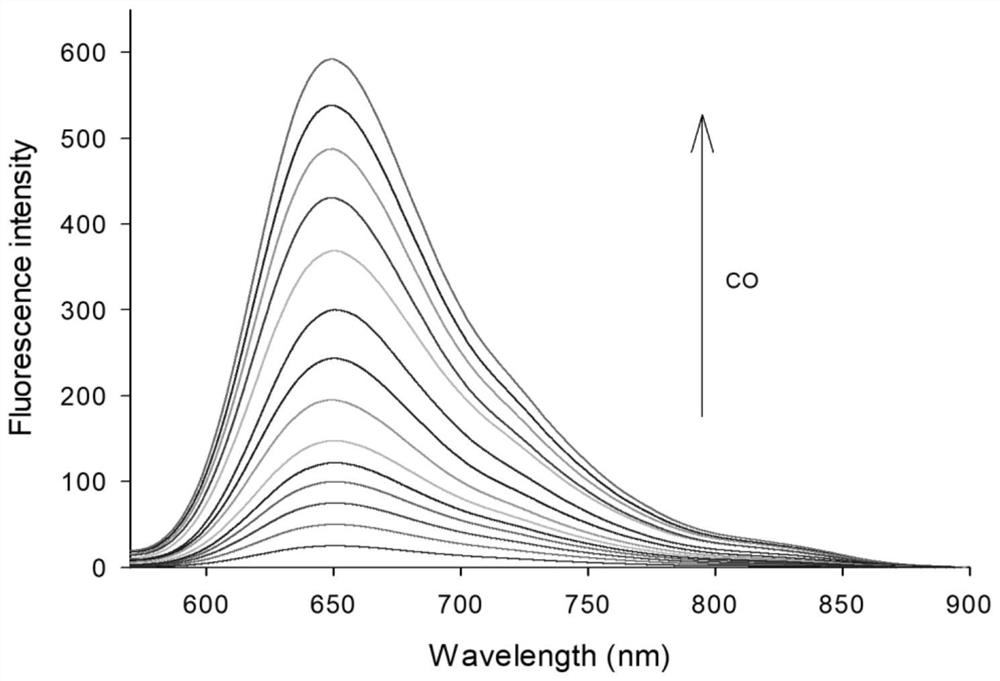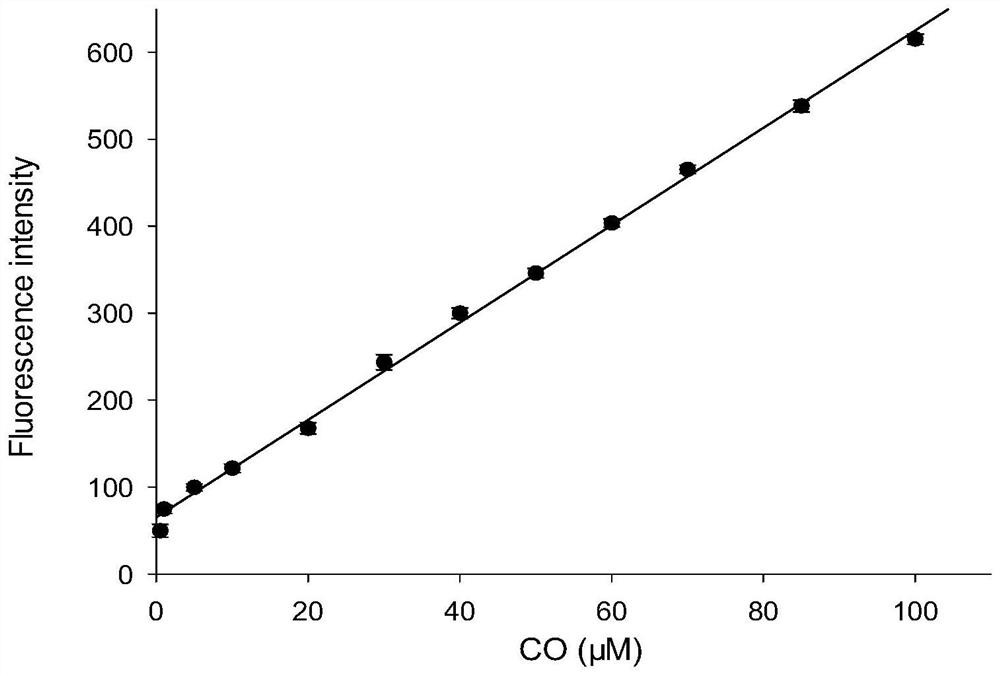Preparation and application of solid fluorescent probe for detecting carbon monoxide
A solid-state fluorescence and carbon monoxide technology, applied in the field of fluorescent probes, can solve the problems of short wavelength and limited application of solid-state fluorescent probes
- Summary
- Abstract
- Description
- Claims
- Application Information
AI Technical Summary
Problems solved by technology
Method used
Image
Examples
Embodiment 1
[0027] Synthesis of solid state fluorescent probes
[0028] Synthetic route figure 1 .
[0029] Synthesis method of solid state fluorophore HPQ-MQ-OH: 0.35 g 1-ethyl-2-methylquinoline (1 mmol), 0.30 g 3- (7-chloro-4-oxygen-3,4-dihydroquinazole) Pyloline) -4-hydroxybenzaldehyde (1 mmol), 20.0 ml of acetonitrile sequentially added to a 100 ml round bottom flask. Then, 0.2 ml of piperidine was added with a microformor, and the reflux reaction was stirred at 80 ° C for 15 h, and the solvent was evaporated. The solid product was dissolved with dichloromethane, extracted three times with saturated brine, dried the lower organic phase, filtered, evaporated, solid products in CH 2 CL 2 / CH 3 OH = 100: 7 (volume ratio) was column chromatography to the eluent, resulting in 0.22 g of reddish brown solid product (HPQ-MQ-OH), and the yield was 50%.
[0030] Synthesis of HPQ-MQ-MQ-MQ-MQ-MQ-MQ-MQ-MQ-MQ-MQ-MQ-CO: 0.25 g of HPQ-MQ-OH (1 mmol) is dissolved under 10 ml of dry CH under ice bath and ...
Embodiment 2
[0032] Solid state fluorescent probe and CO solution formulated
[0033] Preparation of the probe solution: Weigh a certain amount of probe in dimethyl sulfoxide, formulated into 1 × 10 -4 M The probe solution. At the same time, we can weigh a certain amount of PDCL. 2 Dissolve in secondary distilled water, equipped with 1 × 10 -4 M solution. Handling of CO solution: dissolve a certain amount of CORM-3 in secondary distilled water, transferred to a 500 mL volumetric flask, add water to the scale, to give a concentration of 1.0 × 10 -3 M's CORM-3. Will 1.0 × 10 -3 M's CORM-3 solution gradually dilute, get 1.0 × 10 -6 -1.0 × 10 -3 Mol·L -1 CORM-3 aqueous solution. 1.0ml probe solution, 1.0ml of PDCl 2 The solution and 1.0 ml of CORM-3 aqueous solution were added to 10 ml of volumetric flask, and the concentration was 1.0 × 10 after the buffer solution was allowed to obtain a concentration of 1.0 × 10. -5 Fluorescent probe and PDCl 2 , 1.0 × 10 -7 -1.0 × 10 -4 M The CO mixed to be te...
Embodiment 3
[0035] Determination of fluorescence spectrum of solid fluorescence probes and CO effects
[0036] figure 2 Fluorescence spectrum, solid fluorescent probe and PD for solid state fluorescence probes and CO 2+ The concentration was 10 μm, and the Co concentration was: 0, 0.1, 0.5, 1, 5, 10, 20, 30, 40, 50, 60, 70, 80, 90, 100 μm. The excitation wavelength is fixed to 550 nm, and the emission wavelength ranges from 620 to 670 nm. The slit width was 5.0 nm / 5.0 nm, and the fluorescent assay used was a daiser F4600 fluorescence spectrophotometer. From figure 2 It can be seen that the probe itself emits weak fluorescence due to the quenching effect of allyl carbone. Add PD 2+ After Co, a significant emission peak appeared at 650 nm. This is because PD 2+ First by Co reduction as a PD 0 The Tsuji-Trost reaction is then mediated, resulting in the breakage of the allyl carbone, releases fluorophore, resulting in a fluorescent signal. And as the Co concentration increases, the fluorescenc...
PUM
 Login to View More
Login to View More Abstract
Description
Claims
Application Information
 Login to View More
Login to View More - R&D
- Intellectual Property
- Life Sciences
- Materials
- Tech Scout
- Unparalleled Data Quality
- Higher Quality Content
- 60% Fewer Hallucinations
Browse by: Latest US Patents, China's latest patents, Technical Efficacy Thesaurus, Application Domain, Technology Topic, Popular Technical Reports.
© 2025 PatSnap. All rights reserved.Legal|Privacy policy|Modern Slavery Act Transparency Statement|Sitemap|About US| Contact US: help@patsnap.com



